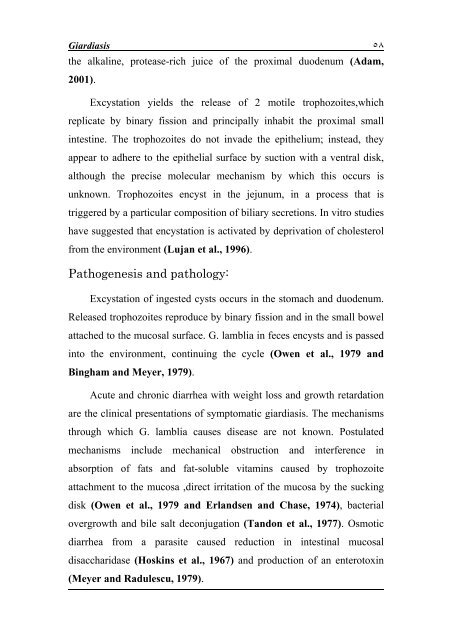Parasites and Biliary stones
Parasites and Biliary stones
Parasites and Biliary stones
Create successful ePaper yourself
Turn your PDF publications into a flip-book with our unique Google optimized e-Paper software.
Giardiasis ٥٨<br />
the alkaline, protease-rich juice of the proximal duodenum (Adam,<br />
2001).<br />
Excystation yields the release of 2 motile trophozoites,which<br />
replicate by binary fission <strong>and</strong> principally inhabit the proximal small<br />
intestine. The trophozoites do not invade the epithelium; instead, they<br />
appear to adhere to the epithelial surface by suction with a ventral disk,<br />
although the precise molecular mechanism by which this occurs is<br />
unknown. Trophozoites encyst in the jejunum, in a process that is<br />
triggered by a particular composition of biliary secretions. In vitro studies<br />
have suggested that encystation is activated by deprivation of cholesterol<br />
from the environment (Lujan et al., 1996).<br />
Pathogenesis <strong>and</strong> pathology:<br />
Excystation of ingested cysts occurs in the stomach <strong>and</strong> duodenum.<br />
Released trophozoites reproduce by binary fission <strong>and</strong> in the small bowel<br />
attached to the mucosal surface. G. lamblia in feces encysts <strong>and</strong> is passed<br />
into the environment, continuing the cycle (Owen et al., 1979 <strong>and</strong><br />
Bingham <strong>and</strong> Meyer, 1979).<br />
Acute <strong>and</strong> chronic diarrhea with weight loss <strong>and</strong> growth retardation<br />
are the clinical presentations of symptomatic giardiasis. The mechanisms<br />
through which G. lamblia causes disease are not known. Postulated<br />
mechanisms include mechanical obstruction <strong>and</strong> interference in<br />
absorption of fats <strong>and</strong> fat-soluble vitamins caused by trophozoite<br />
attachment to the mucosa ,direct irritation of the mucosa by the sucking<br />
disk (Owen et al., 1979 <strong>and</strong> Erl<strong>and</strong>sen <strong>and</strong> Chase, 1974), bacterial<br />
overgrowth <strong>and</strong> bile salt deconjugation (T<strong>and</strong>on et al., 1977). Osmotic<br />
diarrhea from a parasite caused reduction in intestinal mucosal<br />
disaccharidase (Hoskins et al., 1967) <strong>and</strong> production of an enterotoxin<br />
(Meyer <strong>and</strong> Radulescu, 1979).
















